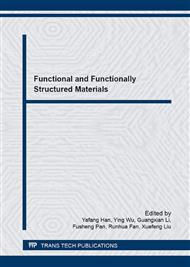[1]
H.C. Yan, H.T. Yuan, G. Feng, Modification of poly(ethylene terephthalate) by combination of reactive extrusion and followed solid-state polycondensation for melt foaming, Jouranl of Applied Polymer Science. 42708(2015) 1-11.
DOI: 10.1002/app.42708
Google Scholar
[2]
I. Onyshchenko, A.Y. Nikiforov, N.D. Geyter, Local analysis of PET surface functionalization by an atmospheric pressure plasma jet, Plasma Process and Polymers. 12(2015) 466-476.
DOI: 10.1002/ppap.201400166
Google Scholar
[3]
S.K. Liu, J.Q. Hu, W.P. Tu, Development in waterborne technology and product stability of waterborne polyester resins, Chemical Industrial and Engineering Progress. 28(2009) 1376-1381.
Google Scholar
[4]
D. Caron, A. Fradet, E. Marechal, Synthesis and study of water-soluble alkyd resins with high long chain fatty acid contents, Surface Coatings International. 2(1985) 40-45.
Google Scholar
[5]
N. Yasuhiko, I. Shigeru, M. Shoichi, Waterbone polyester paint: US, 5597861[P]. 1997-01-28.
Google Scholar
[6]
L.H. Lin, H.J. Liu, J.J. Hwang, Preparation and dispersion properties of water-soluble polyethylene glycol-dimethyl 5-sulfoisophthalate sodium salt polyester surfactants, Colloids and Surfaces A. 211(2002) 173-178.
DOI: 10.1016/s0927-7757(02)00275-3
Google Scholar
[7]
Q.Y. Qi, W.X. Chen, W.M. Qing, Rheological behavior of water-soluble polyester, Journal of Textile Research. 29(2008) 11-14.
Google Scholar
[8]
D.K. Gilding, A.M. Reed, Biodegradable polymers for use in surgery polyglycolic/poly(actic acid) homo- and copolymers, Polymer. 20(1979) 1459-1464.
DOI: 10.1016/0032-3861(79)90009-0
Google Scholar
[9]
A.M. Reed, D.K. Gilding, Biodegradable polymers for use in surgery, Polymer. 22(1981) 499-504.
Google Scholar
[10]
W. Dong, M.H. Wu, J.H. Chen, Synthesis and properties of new polyester polyether copolymer hydrophilic finishing agent, Journal of Textile Research. 32(2011) 73-78.
Google Scholar
[11]
M.H. Wu, H.N. Hu, H.M. Lin, et al., Influencing factors of hydrophilicity of polyesterpolyether block copolymer finishing agent, Journal of Functional Polymers. 1(2007) 69-73.
Google Scholar
[12]
L. Phong, E. Sheng, C. Han, Properties and hydrolysis of PLGA and PLLA cross-linked with electron beam radiation, Polymer Degradation and Stability. 95(2010) 771-777.
DOI: 10.1016/j.polymdegradstab.2010.02.012
Google Scholar
[13]
X. Liu, K. Xu, H. Liu, Preparation and properties of waterborne polyurethanes with natural dimer fatty acids based polyester polyol as soft segment, Progress in Organic Coatings. 07(2011) 1-9.
DOI: 10.1016/j.porgcoat.2011.07.002
Google Scholar
[14]
Y.P. Wang, Y.M. Wang, W.B. He, Hydrolysis-resistant polyethylene terephthalate (PET) fiber, Journal of Donghua University. 2(2006) 76-78.
Google Scholar
[15]
R.S. Chen, C.J. Chang, Y.H. Chang, Study on siloxane-modified polyurethane dispersions from various polydimethylsiloxanes, Journal of Polymer Science: Part A. Polymer Chemistry. 43(2005) 3482-3470.
DOI: 10.1002/pola.20805
Google Scholar
[16]
J. Li, Z.Q. Jiang, Z.B. Wang, Synthesis, crystallization and hydrolysis of aromaticealiphatic copolyester: Poly(trimethylene terephthalate)-co-poly(L-lactic acid), Polymer Degradation and Stability. 96(2011) 991-999.
DOI: 10.1016/j.polymdegradstab.2011.01.023
Google Scholar
[17]
C.G.G. Namboori, M.S. Haith, Steric effects in the basic hydrolysis of Poly(ethy1ene terephthalate), Journal of Applied Polymer Science. 12(1968) 1999-(2005).
DOI: 10.1002/app.1968.070120901
Google Scholar
[18]
D.M. LeMaster, G. Hernandez, NMR analysis of polyester urethane end groups and solid-phase hydrolysis kinetics, Macromolecules. 33(2000) 3569-3576.
DOI: 10.1021/ma992030w
Google Scholar
[19]
S. Murata, T. Nakajima, N. Tsuzaki, Synthesis and hydrolysis resistance of polyurethane derived from 2, 4-diethyl-1, 5-pentanediol, Polymer Degradation and Stability. 61(1998) 527-534.
DOI: 10.1016/s0141-3910(97)00252-8
Google Scholar
[20]
M. Elomaa, T. Asplund, P. Soininen, et al., Determination of the degree of substitution of acetylated starch by hydrolysis, 1H NMR and TGA/IR, Carbohydrate Polymers. 57(2004) 261-267.
DOI: 10.1016/j.carbpol.2004.05.003
Google Scholar
[21]
E.T. Turpin, Hydrolysis of water-dispersible resins, Journal of Paint Technology. 47(1975) 40-46.
Google Scholar
[22]
C.X. Xiao, W.G. Li, X.A. Huang, Study on compatibility of PET/PTT blend systems, Synthetic Fiber in China. 6(2003) 22-25.
Google Scholar


